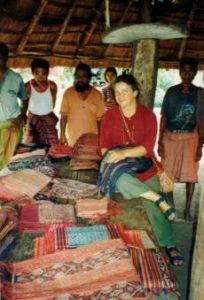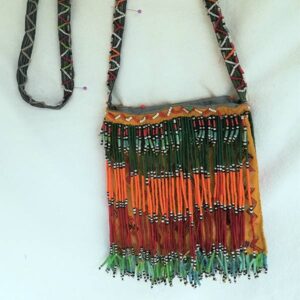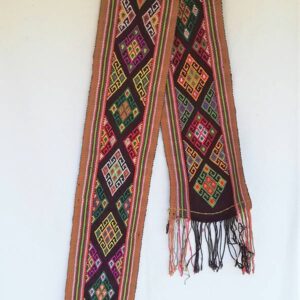Timor Textile Ikat Tradition – Unique hand woven scarves scarf runners shawls blankets tubular sarongs
Documentation of Timorese textile
Very few notable texts have been written over the last century focusing on the diversity and complexity of Timorese textiles, Ruth Yeager and Mark Jacobson’s treatise on West Timorese textiles is the most comprehensive. Originally published in black and white in 1995, the current edition (2002) is a colour plate version, entitled “Studies in Material Cultures of South-east Asia No. 2: Textiles of Western Timor, Regional Variations in Historical Perspective”. ISBN 974-4800-01-1. This book gives a fabulously in-depth look at the diverse range of motifs and construction in Timorese textiles, and how they fit into Timorese society.
One of the first publications documenting Timorese textiles and craft is – To speak with Cloth. Studies in Indonesian Textiles. Gittinger, Mattiebelle. (Ed.) however the section dedicated to Timorese textiles is scant at best. More recently there have been academic papers, focusing on particular regions, written about the complexity of Timorese textiles and a book Ikat FROM TIMOR AND ITS OUTER ISLANDS – Insular and Interwoven by Peter ten Hoopen | 2022 offers us an in-depth look at this highly underrated textile tradition.
Of East Timorese textiles very little has been recorded, though I have seen some photographs in Portuguese books of the 1920s and 30s depicting colonial life in the East Indies. More recently the Alola Foundation in East Timor has gained https://www.timorleste.tl/timor-leste-gains-international-recognition-for-tais-as-an-intangible-cultural-heritage-in-need-of-urgent-safeguarding/.
Oh for a submission writer that could step up for West Timorese textiles whose variety and intricacy far surpasses that of East Timor. Granted East Timor has had a torrid time over the last 40 years and it is a credit to the wonderful weaving women that they have taken up the loom again at all.
Since I began trading and collecting Timorese textiles I have photographed and recorded details of over 2000 cloths that have passed through my hands as well as many of ‘the ones that got away’. The result is a photographic and catalogue documentation of the huge range, variety and diversity present within the cloths.
As for the carving tradition that is still alive on Timor today even less has been written or documented. I do with the craft the same as I do with the textiles I trade. I document, photograph and catalogue all of the craft I have traded to date. This is partly for selling on platforms such as my website www.timortreasures.com and the international go to trading platform Ebay as timorgirl but mostly for I document for the historical record.
Weaving of textiles in Timor
Timorese Textiles are unique, a tradition in their own right. No two weavings are the same as the weaver is not ‘allowed’ to weave the same “story” twice.
Cloth’s are still woven on a simple back strap loom which is held into place by Y-shaped sticks. The weaver herself provides the tension, by placing her feet on a backboard whilst seated.
Scarves, blankets and sashes are worn by males while tubular sarongs and scarves adorn women in Timor. Women also weave betel nut bags for men’s use.
There are 5 main forms of woven object
- Selimut or bete naek – the men’s blanket, represents traditional men’s clothing. Men usually have 2, one being worn as a skirt held up by the sash, and the other either around the waist or slung across the shoulder by day and wrapped around the shoulder by night. Constructed from 2 or 3 panels that are carefully patterned so as to match perfectly when joined they make excellent shawls, throws for chairs and sofa’s or covers for TV’s or computers.
- Sarong or tais – the tubular women’s cloth is worn as a skirt by day, cleverly folded and tucked to keep it in place, with a blouse and pulled up over the shoulders at night. It is woven in two or three panels, joined and stitched at the ends to form the tube. Easily adapted to a unique and fashionable skirt as it is possible to unpick the seams of the tube and tailor it. Weavers will often create a shoulder throw to match which doubles as their scarf
- Selendang or mau ana – scarves are worn by both men and women for warmth (it gets cold up in the mountains), to keep the sun off ones head, to help stabilize parcels such as bundles of firewood or cow fodder and water pots on the head and as a handy easy to wash sweat wipe.
- Ikat pinggang or saluf – a waist belt/sash otherwise known as a kidney belt, is worn by the men to hold up the blanket and usually has elaborately decorated fringes.
- Betel Nut Bag or aluk – men use these cloth woven bags to hold their betel nut accessories and a small knife and use as a school bag is being encouraged amongst the children. The women use pandanus woven bags called mama tas for their betel nut and other handbag items.
Note: Commercial thread is smoother and thinner than hand-spun cotton.
Most Timorese also have their ‘ Sunday Best’. Cloth’s that are worn for special occasions such as dowry exchanges, wedding and funeral attire, to being buried with the deceased, official meetings, church, parties, ceremony and offerings to the ancestors.
Timorese who marry in the church also have a traditional ceremony in their village where woven textiles play a major role. At the 2005 funeral of the King or Usif of one of the animist villages it was required, by tradition, that he be wrapped in 100 cloths. Textiles also play an important role in gift giving ceremonies. As with most islands in the Indonesian archipelago each has a distinct weaving tradition. Identity, familial relationships, and status are intricately tied to Timorese cloth.
Furthermore, Timorese textiles are created with very identity specific design motives and are tied to designated areas. It is possible to identify the wearer’s village and family from the motif, construction and colors of each weaving. These vary every 3-5km giving the richest array of styles and combinations in the Indonesian archipelago.
There are 3 dominate weaving techniques used by the weaving women. Kelim is also practiced in certain areas as a part of their weaving tradition.
IKAT or futus meaning to tie, denotes the pieces where the warp thread is carefully tied off to produce the motif or pattern. It is then dyed and woven. LOTIS or sotis is supplementary weft or float weave, where the weft threads are pulled through to create a negative image on the reverse side BUNA weaving is where the embroidery thread is wrapped and worked into the weft creating the motif decoration in the weaving, it is also the most time consuming of the weaving processes.
When travelling off the main roads you may be fortunate to see women weaving, seated at their looms during the quiet times of the day beneath the “afternoon rest” place called a lopo. Weaving is not a full-time occupation, rather it is squeezed between the cooking, the kids, the corn, the water carting and other regular chores. A few men also weave, but, again, that’s another story.
Other examples of weaving
Women also weave mats, baskets, containers, purses and bags from pandanus, lontar and gewang grass. Ceremonial betel nut receiving boxes have a really cool shallow basket inlaid top (in order to politely keep some betel aside for a later chew), and sometimes a secret compartment for special papers or the occasional photograph.
© Julie Emery / Timor Treasures 2022



